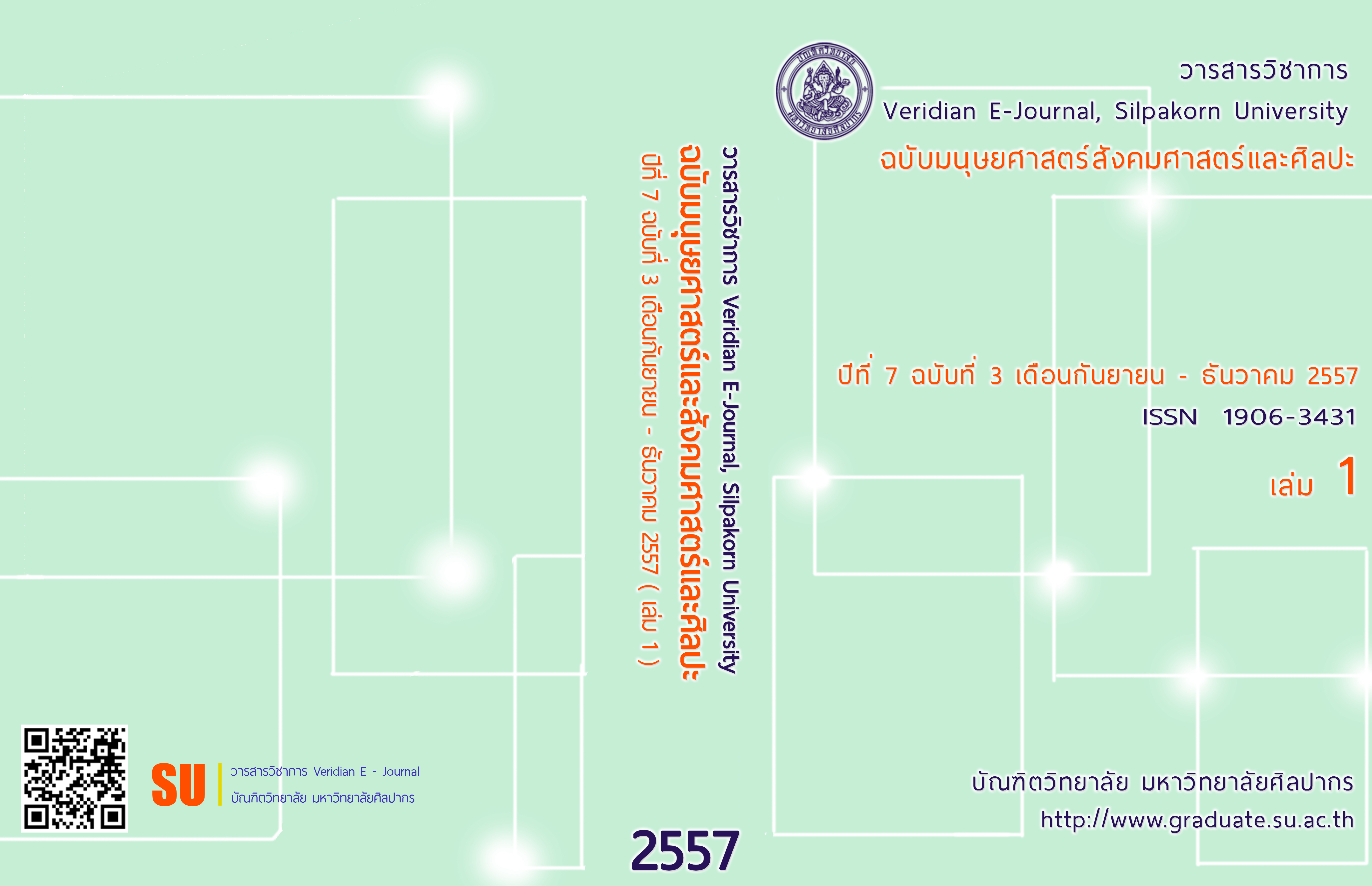การพัฒนาบทเรียนคอมพิวเตอร์มัลติมีเดีย เรื่องเส้นแสงสีเงา เพื่อพัฒนาความสามารถในการออกแบบ วิชาศิลปะ ของนักเรียนชั้นประถมศึกษาปีที่ 4 *
Main Article Content
Abstract
บทคัดย่อ
การวิจัยครั้งนี้มีวัตถุประสงค์ 1) เพื่อพัฒนาบทเรียนคอมพิวเตอร์มัลติมีเดีย เรื่อง เส้นแสงสีเงา สำหรับนักเรียนชั้นประถมศึกษาปีที่ 4 ให้มีประสิทธิภาพตามเกณฑ์ที่กำหนด 2) เพื่อเปรียบเทียบผลสัมฤทธิ์ทางการเรียนของนักเรียนชั้นประถมศึกษาปีที่ 4 ก่อนเรียนและหลังเรียนจากบทเรียนคอมพิวเตอร์มัลติมีเดีย เรื่องเส้นแสงสีเงา 3) เพื่อศึกษาความสามารถในการออกแบบจากการเรียนด้วยบทเรียนคอมพิวเตอร์มัลติมีเดีย เรื่อง เส้นแสงสีเงา 4) เพื่อศึกษาความพึงพอใจของนักเรียนชั้นประถมศึกษาปีที่ 4 ที่มีต่อบทเรียนคอมพิวเตอร์มัลติมีเดีย เรื่องเส้นสีแสงเงา กลุ่มตัวอย่างที่ใช้ในการวิจัยในครั้งนี้ เป็นนักเรียนชั้นประถมศึกษาปีที่ 4 จำนวน 30 คน โดยการสุ่มแบบยกชั้น (Cluster Random Samping ) เครื่องมือที่ใช้ในการวิจัยประกอบด้วย 1) แบบสัมภาษณ์แบบมีโครงสร้างสำหรับสัมภาษณ์ผู้เชี่ยวชาญ 2)บทเรียนคอมพิวเตอร์มัลติมีเดีย เรื่อง เส้นแสงสีเงา 3) แบบประเมินคุณภาพบทเรียนคอมพิวเตอร์มัลติมีเดีย 4) แบบทดสอบวัดผลสัมฤทธิ์ทางการเรียน 5) แบบทดสอบวัดความสามารถในออกแบบ 6) แบบประเมินความพึงพอใจของผู้เรียนสถิติที่ใช้ในการวิเคราะห์ข้อมูลใช้ค่าร้อยละ(% ) ค่าเฉลี่ย( ) ส่วนเบี่ยงเบนมาตรฐาน(S.D.) และสถิติทดสอบค่าที (t-test ) dependent
ผลการวิจัยพบว่า
1) บทเรียนคอมพิวเตอร์มัลติมีเดีย เรื่อง เส้นแสงสีเงา วิชาศิลปะ สำหรับนักเรียนชั้นประถมศึกษาปีที่ 4 ที่ผู้วิจัยสร้างขึ้นมีประสิทธิภาพ 82.33/81.67 ซึ่งมีประสิทธิภาพตามเกณฑ์ที่กำหนดไว้2) ผลสัมฤทธิ์ทางการเรียนของนักเรียนที่เรียนด้วยบทเรียนคอมพิวเตอร์มัลติมีเดีย เรื่อง เส้นแสงสีเงา วิชาศิลปะ ของนักเรียนชั้นประถมศึกษาปีที่ 4 ผลสัมฤทธิ์หลังเรียนสูงกว่าก่อนเรียน อย่างมีนัยสำคัญทางสถิติที่ระดับ .05
3) ความสามารถในการออกแบบของนักเรียนที่เรียนด้วยบทเรียนคอมพิวเตอร์มัลติมีเดีย เรื่อง เส้นแสงสีเงาวิชาศิลปะ เท่ากับ 75.15 ซึ่งสูงกว่าเกณฑ์ร้อยละ 70
4) ความพึงพอใจของนักเรียนที่มีต่อการเรียนด้วยบทเรียนคอมพิวเตอร์มัลติมีเดีย เรื่องเส้นแสงสีเงา เพื่อพัฒนาความสามารถในการออกแบบ อยู่ในระดับมาก
Abstract
The purpose of this research were 1) To developing the computer multimedia on light and shadow lines for pathomsuksa four students to The performance-based criteria. 2) to compare the achievement of pathomsuksa four students before and after learning of computer multimedia. The sleek lines and light 3) the ability to design a computer multimedia class with sleek lines and light 4) to the satisfaction of the 4th grade students on Multimedia. The shaded lines The samples used in this research. The 4th grade students of 30 randomly picking a class (Cluster Random Samping) were used in this study were 1) a structured interview to interview experts. 2) Computer Multimedia rays shiny 3) the quality of computer multimedia, 4) test achievement 5) test measures the ability to design 6) the satisfaction of the student statistics used to. data were analyzed using percentage (%), mean ( ), standard deviation (SD) and statistics, t-tests (t-test) dependent.
The results showed that: 1) Computer Multimedia linear light shadow color art for students in grade 4, which were made effective 82.33 / 81.67 which efficiency criteria defined 2) Achievement of. students who study with light and shadow lines, computer multimedia arts student's grade 4 achievement were higher than pretest. Are statistically significant at the .05 level. 3) ability to design student learning with computer multimedia on-line light shadow art of 80.15, higher than the 70 percent 4) satisfaction of the students. to learn with computer multimedia. The sleek lines and light To develop ability to design. At a high level
